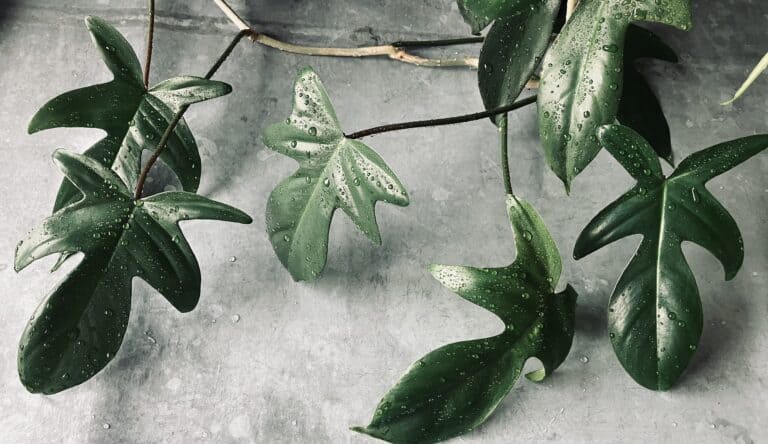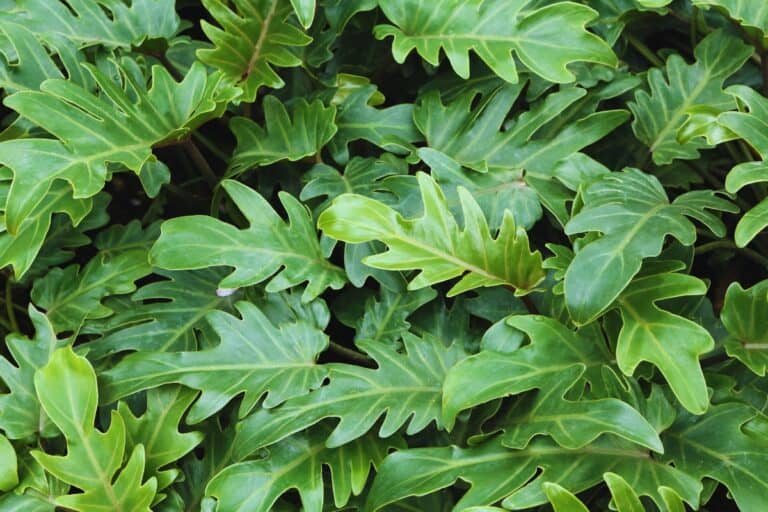What is so special about Philodendron Birkin?
This plant has wowed more than a few plant lovers, and there’s a good reason why. It’s like a fashion show superstar with its fancy striped look. A while back, when it first showed up in stores, everyone went bananas for it. Plant fans couldn’t get enough, and the prices shot up like a rocket.
But guess what? Nowadays, it’s not as hard to find as a hidden treasure map. You can stumble upon this beauty at your local plant shop or even in the grocery store, and it won’t cost you a mountain of gold. You can scoop one up for just a few bucks.
So, why did this plant become so famous? And why have some folks lost their crush on it? In this story, we’re going on a little adventure to discover the hidden quirks of this seemingly flawless plant.
Why is it called Philodendron Birkin?
Let’s kick off our investigation by figuring out why it’s named Birkin, like some fancy Hermes bag. While there’s no official backstory about this plant and where it got its name, a quick glance at Philodendron Birkin might give us a clue. It could be inspired by the same muse as that famous bag – the British-French actress and singer, Jane Birkin.
This theory holds water for the bag (they spill the design story on their website), and it makes a lot of sense for the striped plant too. If you do a quick Google search for ‘Jane Birkin style,’ you’ll notice it’s all about simplicity and clean lines – just a pair of jeans and a plain white or striped tee would be a good example. Those stylish striped tops might just be the spark behind the plant’s snazzy marketing name.
Where does Philodendron Birkin come from?
The tale of this plant’s origins could hold the key to many mysteries about its well-being. However, as we mentioned earlier, there’s no “official” story to be found. It’s like this plant just dropped out of the sky into the world of houseplants. What we do know is that it didn’t come from the wild—it’s a product of modern horticulture.
The leading theory is that it’s a “sport,” which basically means a chance genetic mutation, of another hybrid plant called ‘Rojo Congo’. But when you put these two plants side by side, that theory starts looking shaky. They don’t have much in common at all. ‘Rojo Congo’ has bigger leaves that are a completely different color, and its stems are purple-brown.
In short, ‘Rojo Congo’ and P. Birkin don’t exactly look like long-lost twins. So, why do some folks believe ‘Rojo Congo’ is like the Darth Vader to our Birkin Skywalker? Well, because P. Birkin has a tendency to “revert” back to its roots. When you see the first funky-looking half-moon or fully reverted leaf pop up, you can’t believe your eyes. Then you have to admit that your lovely mutant has gone all nostalgic and decided to return to its original form.
We’ll dive deeper into this “reverting” thing later, but first, let’s try to piece together the possible story of Philodendron Birkin. So, picture this: Somewhere, at some point, in a nursery that churns out tropical leafy pals, including ‘Rojo Congo’, a tiny little mutant is born. It’s so darn pretty that they can’t just toss it aside like a dud. So, the nursery folks decide to make more of it. With modern tissue culture methods, you don’t need two plant parents to whip up a new plant. You can simply take a few tissue cells and create an army of clones. And that’s exactly what they did. The extraordinary mutation was multiplied and unleashed onto the market. Plant enthusiasts loved it.
But here’s the twist: it turns out this mutation isn’t super steady. The plant can change its mind and ditch the striped outfits altogether, or it might go on a fashion frenzy, mixing and matching wild colors. Some plant parents find this unpredictability thrilling; they never know what their quirky plant will do next. Others, well, they get a bit tired and frustrated, especially if those bright stripes were the main reason they brought the plant home.
This instability is probably why Philodendron Birkin never got a patent, unlike the original ‘Rojo Congo’, which boasts characteristics that “are in fact stable and reproduced true to type in successive generations” (US Patent USPP14116P3).

Is Philodendron Birkin hard to care for?
That’s a tricky question. Every plant parent’s aim is to keep their plant happy and looking good, and usually, those two things go hand in hand. But with the ever-changing appearance of Philodendron Birkin, your plant could be perfectly healthy and content while causing major disappointment to the owner at the same time.
Now, if the unpredictable nature of this funky mutant hasn’t scared you off, and you’re ready to embrace whatever leaves this plant throws your way, then taking care of a Philodendron Birkin can be a breeze. After all, the original ‘Rojo Congo’ was designed to be a robust and easy-to-care-for plant. Many plant parents report that these beauties just keep sprouting surprising new leaves and don’t cause any trouble at all.
However, if your goal is to maintain that elegant striped look of the plant, depending on your home environment, it can become quite a puzzle. There’s no surefire recipe to keep those stripes going while also preventing reversion. With Philodendron Birkin, it’s a journey of trial and error mixed with a good dose of luck.
In the patent for the original ‘Rojo Congo’ they mention that the phenotype (a.k.a. the looks) of the plant may vary depending on “temperature, light intensity, day length, fertilization, irrigation, propagation procedures etc.” (this ‘etc.’ part seems particularly encouraging), so the elusive Philodendron Birkin sport can also depend on all those factors.
The new Philodendron cultivar has not been observed under all possible environmental conditions. The phenotype may vary somewhat with variations in environment and/or horticultural practices such as temperature, light intensity, day length, fertilization, irrigation, propagation procedures etc., without any variance in genotype
US Patent USPP14116P3 – Philodendron plant named ‘Rojo Congo’
Reverting can be a real wild card – it’s tough to predict. But if it happens, here’s the game plan. Rule #1: Stay calm. Keep an eye on it. You might end up embracing the plant as it is. But if that’s not your style, try giving it more light and see what the next leaf looks like. If your Birkin seems dead set on going back to its old ways, and you’re missing those stripes, some Birkin owners suggest snipping off the reverted part. Cross your fingers that the older section of the stem remembers the good old striped days and sprouts some regular Birkin leaves. If you’re lucky, you might wind up with two plants that look totally different, and a great conversation starter.
But here’s the thing: reverting isn’t a must, and you might never have to deal with it. So, let’s set that aside and focus on another delicate matter – the variegation. Even without reverting, Philodendron Birkin can be a bit frustrating if it keeps producing fully green leaves. On the flip side, some Birkin parents grumble about completely white leaves that might look stunning at first but quickly turn brown and drop off.
It’s crucial for the plant’s well-being to strike the right balance between green and white leaf parts. Recent studies have uncovered that the white sections of the leaf play a vital role in the overall growth process of the plant. Surprisingly, the green and white parts have different jobs in terms of metabolism. The green parts handle photosynthesis and excel in carbon metabolism, while the white parts are like nitrogen metabolism experts. They store nitrogen and whip up amino acids, which are also super important for the plant’s healthy growth.
Now, in most plants, you’ll see more variegation when they get more light, especially when it’s combined with cooler temperatures. So, in simple terms, if the plant gets tired of all that photosynthesis work, it starts growing whiter leaves to take a breather. And if the plant gets a nitrogen overload, it adds more white to stockpile the excess until it’s needed. Keep this in mind when you’re trying to create the perfect conditions to keep your P. Birkin thriving.
Here are the main things to remember for taking care of your Philodendron Birkin:
- Don’t stress too much. With a little luck, you might not encounter all the reverting and variegation issues. Place your plant where you think it fits best and let it adjust. Only make changes if you see clear signs that it needs them.
- If your plant starts growing entirely green leaves, try giving it more light and see how it responds. On the flip side, if your Birkin keeps producing fully white leaves, think about moving it a bit further from the window and check your fertilizer. It might be packing too much nitrogen.
- For everything else, just give your beautiful mutant plant the usual dose of love and care, and you should be in good shape.
Happy plant parenting!
FAQ
Do Birkin plants grow fast?
Under the right conditions, Philodendron plants can put on a pretty speedy growth show. Some Birkin plant owners say their Birkins keep sprouting new growth all the time. After all, these plants are descendants of Philodendron ‘Rojo Congo’, a cultivar that was specifically designed to be vigorous and robust, among other things.
Now, if your Philodendron Birkin seems to have hit the brakes on its growth, it might be due to less-than-ideal conditions. No biggie if it’s just because of seasonal changes. But if your plant seems like it’s taking a permanent nap, even when the days get longer and warmer, it’s probably time to give it a little wake-up call. Check the soil, move it around, or add some fertilizer to shake things up a bit.
Does Philodendron Birkin like to climb?
Philodendron Birkin is a sport of the patented Philodendron cultivar named ‘Rojo Congo’, which is described as a “vigorous, self-heading, not vining and self-supporting Philodendron cultivar” (see US Patent USPP14116P3). Even though Philodendron Birkin tends to have smaller leaves and slightly longer internodes than its parent, it remains a self-heading Philodendron and normally does not require a moss pole. But if your Birkin starts feeling a bit top-heavy or leaning more on one side, just use some common sense and stick in a stake to keep it from tipping over.



